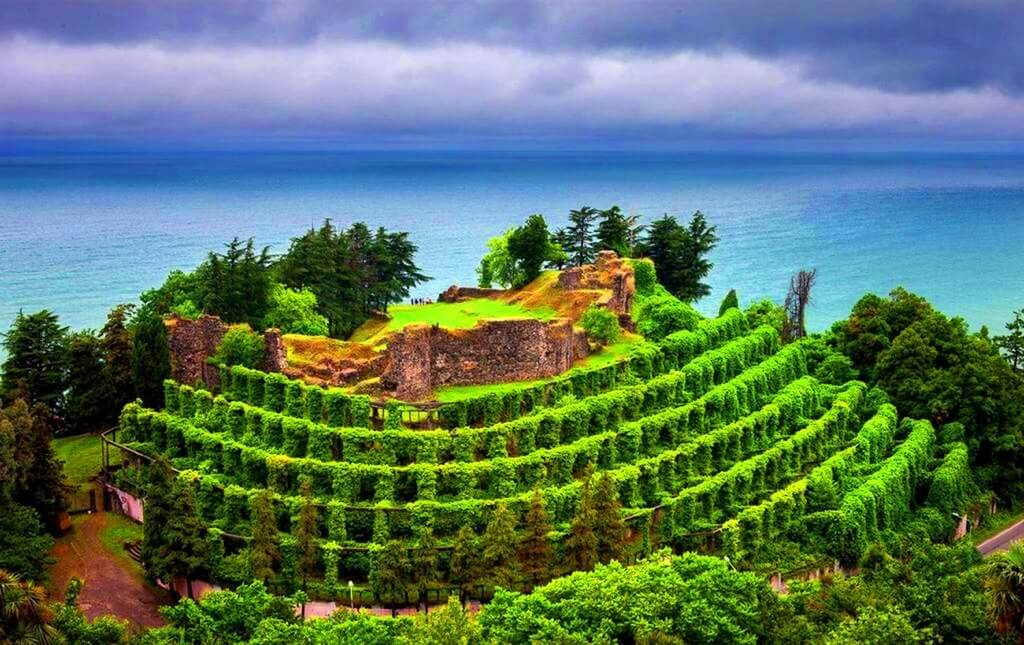Batumi Botanical Garden

Batumi Botanical Garden was built on a 108,7-hectare shoreline of the Black Sea between the mouth of Chakvistskali River and Mtsvane Kontskhi (the Green Cape). It is on an elevation between 0 and 200 meters from sea level and is located 9 km. from the center of Batumi. From the physical geography perspective, Batumi Botanical Garden has specific and various environments. In the not-so-distant past, it was fully covered by Colchic (beeches, chestnuts, lindens) and evergreen (cherry laurel, rhododendron ponticum, etc.) forests.
In 1881, M. D’Alphonse performed one of the first introductory works. One of the initiators for the introduction of plants to the Black Sea coast was geographer, botanist, and traveler P. Tatarinov, who created the so-called Climatization Garden on the 10-hectare piece of land of Batumi coast (1892). Today, it is known as the Upper Park.
Batumi Botanical Garten was founded in 1912 by the initiative of Prof. A. Krasnov. Initially, it was 71 hectares, but later, another previously built park became part of it. I. Gordeziani played an important role in the formation of the garden. The Botanical Garden consists of three parks – lower, upper, and seaside (plants here are for decorative purposes). It has a Colchic forest reserve (containing taxonomic units of Adjaran origin). Thanks to landscaping that takes into account local geography, the garden consists of nine floristic sectors, those of Caucasian humid subtropics, East Asia, New Zealand, North America, South America, the Himalayas, Mexico, Australia, and the Mediterranean. The garden collection comprises 2037 taxonomic units of woody plants. Here we have a large variety of plants from East Asia and North America. The collection of plants from the New Zealand and South America is relatively poor. The garden has numerous exotic plants such as Hovenia dulcis, Sapindus, evergreen sequoia, giant sequoia, Metasequoia, araucarias, Fatsia japonica (Japanese paper tree), Umbrella pine (pinus pinea), Mexican weeping pine, weeping Taxodium, Sweetgum, Taxodium distichum, Camellia, Manihot, Avocado, Chinese lacquer tree, Campbell's magnolia, evergreen oaks, Azalea indica, eucalyptus, bamboo, etc. There also are Caucasian, namely Colchic species: Rhododendron ungernii and Rhododendron ponticum, Arbutus, Phillyrea, Pontine oak, etc.
Batumi Botanical Garden has many programs to promote conservation, protection of local flora, decorative gardening and floriculture, plant protection, fruit-growing, environmental education, and tourism. The garden staff is actively involved in various research projects.
Batumi Botanical Garden is an important center for spreading knowledge about biology and agriculture. It has connections with more than 150 botanical gardens, universities, and other scientific institutions worldwide. Since 1998, Batumi Botanical Garden has been a member of Botanic Gardens Conservation International. The botanical garden has distinguished herbarium fund and science library.
In 2012, many events were held to celebrate the 100-year anniversary of the botanical garden.
In 2012, there was a proposal to establish the Alpine Garden of Goderdzi. The realization of this idea started in 2016 at Batumi Botanical Garden. The mission of Goderdzi Alpine Garden is to support the collection of local plants that grow at high altitudes and gather them in Alpine Garden to document them, preserve endangered species, and use them for scientific and educational purposes. Goderdzi Alpine Garden is located in Adjara, in Khulo municipality, on the right slope of the Adjara-Trialeti Mountain Range, near Goderdzi resort on Shqernali territory. It occupies a 9,6-hectare area and is on an elevation of 1960 meters from sea level. The territory has numerous habitats. There are forest, field, lake, bog, and rocky ecotopes. There are native species in the Goderdzi Alpine Garden plants collection. At the moment, there are six types of woody plants and around 100 types of grasses.
D. Kharazishvili


